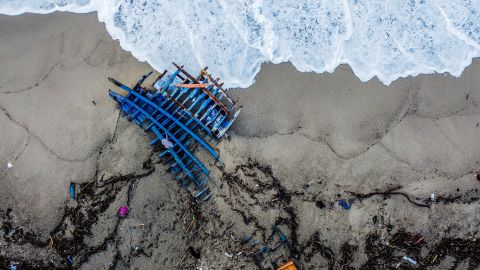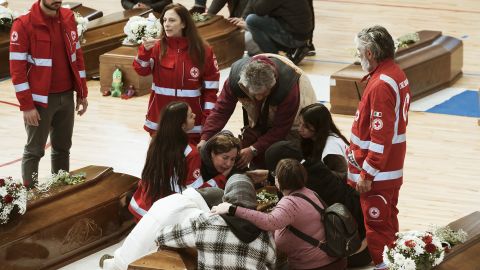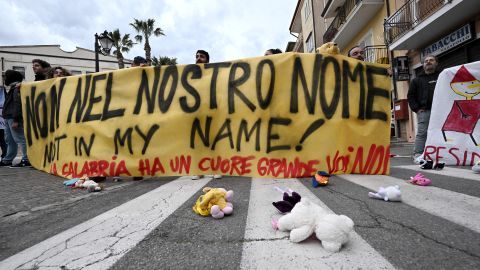CNN
—
Two weeks after a boat full of migrants sank off the coast of southern Italy, there is still no peace for the living or the dead, and the missing – mostly children – continue to s wash up on the beaches.
The latest – a girl aged five or six – was discovered on Saturday morning, raising the death toll from the ill-fated boat breaking on the rocks on February 26 off the village of Cutro to 74. Almost half were minors.
The local coroner’s office provided the names of many of the dead, including Torpekai Amarkhel, a 42-year-old Afghan journalist, who was killed along with her husband and two of their three children.
Her other child, a seven-year-old girl, is among approximately 30 people still missing, presumed dead, from the tragedy.
Amarkhel had fled Afghanistan with his family following the crackdown on women, his sister Mida, who had emigrated to Rotterdam, told Unama News radio, a United Nations project in which Amarkhel was involved.
Shahida Raza, who played football and hockey for the Pakistan national team, was also among the dead. A friend said she was traveling in hopes of securing a better future for her disabled son.
Initially, those found were given alphanumeric code numbers, rather than names. When first responders found the body of Abiden Jafari, 28, from Afghanistan, they identified her only as KR16D45 – KR for nearby Crotone, 16 because she was the 16th victim found, D for gave or wife, and 45, her estimated age.
But after taking her to the morgue, they discovered she was a women’s rights activist who had been threatened by the Taliban, which likely led to her risking her life at sea.
The body of a six-year-old boy, first identified as KR70M6, was named by his uncle Hakef Taimoori.
The uncle had a family photo showing the young boy wearing the same shoes as when he washed up on the beach. His parents and two-year-old brother also died in the disaster. A third brother remains among the missing.
The dead were also caught up in a struggle between the Italian state and family members.
The Interior Ministry has ordered that all bodies be transferred from Calabria, where the coffins have been displayed in an auditorium, to the Islamic cemetery in Bologna for burial, in accordance with Italian protocol for irregular migrants who die attempting to enter Italy.
Family members who survived the sinking or traveled from other parts of Europe to claim the remains of loved ones demonstrated on Wednesday with makeshift signs and a sit-in outside the auditorium.
After a tense negotiation, the Crotone prefecture confirmed to CNN that 25 families, mostly Afghan and Syrian, had agreed to have their loved ones buried in Bologna.
All those who have not been identified will also be buried in Bologna with the remains of a Turkish national who has been identified as one of the human traffickers.


The fate of the others remains a point of negotiation, but the mayor of Crotone Vincenzo Voce said the Italian state would pay for any repatriation to the countries of origin or to be buried with family members in other parts of Italy.
Italy’s Interior Ministry told CNN it could not comment on what would happen to the victims’ remains, but confirmed that past protocol did not include paying to repatriate anyone who died attempting to enter Italy. as an irregular migrant, but to make the country of origin pay. costs. Over the past decade, no repatriation has taken place, the ministry said.
Of the 82 survivors, three Turkish citizens and one Pakistani citizen were arrested for human trafficking, and eight people remain in hospital.
Most of the survivors were moved to a hotel in Crotone this week after human rights campaigners led by left-wing Italian politician Franco Mari protested the conditions they were being held in, which included a bathroom common for men and another for women near the dormitories which only included benches and mattresses on the floor for sleeping.
Mari, who went to the reception center, tweeted that none of the survivors had sheets, towels or pillows. Twelve others were transferred to a reception center for unaccompanied minors.
In the context of the saga about what to do with survivors and victims, there is a growing firestorm over the rescue itself.
A surveillance plane for European border control Frontex had identified the unfortunate ship the day before it sank and alerted the Italian coast guard.
The Coast Guard said in a statement that the vessel was not identified as a migrant boat and in any case did not appear to be in distress.
Heat-detection surveillance footage released by the Coast Guard shows only one person was visible aboard the vessel when they flew over it.
Survivors have told media and human rights groups that they were locked in the ship’s hull and allowed to get air at regular intervals during the four-day journey from Turkey.
The prosecutor’s office in Crotone confirmed to CNN that it had opened a criminal investigation into the circumstances of the failed rescue after more than 40 human rights associations and NGOs signed a petition demanding that all records be made public to determine if anyone has failed to provide assistance to the vessel in accordance with maritime law.
On Thursday, the Council of Ministers led by Prime Minister Giorgia Meloni met on the Cutro disaster and said it would focus on targeting trafficking networks and increasing the prison sentence for drug traffickers. human beings at 30.

Scores of government cars were hit with stuffed animals by protesters in Cutro who held signs reading “not in my name” to protest the blocking of migrants and refugees from entering Europe via Italy.
Ministers also spoke of “accelerating the asylum application mechanism” rather than increasing the quota, which stands at accepting 82,700 asylum-eligible migrants in 2023. So far this year, more 17,600 people reached Italy by sea.
In 2022, 105,131 people entered the country by sea. The asylum process often takes three to five years, depending on the country of origin. People who are not from asylum-producing countries, but who are economic migrants, are repatriated to their country of origin.
Italian President Sergio Mattarella said surviving Afghan citizens would be given priority for asylum. It is not yet clear whether those who do not meet the conditions will be repatriated to their country of origin.
Meloni’s right-wing government has pledged to crack down on human traffickers and NGO rescue ships. But the boats are still arriving – hundreds of migrants were rescued over the weekend – and there are signs they are arriving sooner than ever. This drama will probably not be the last.
